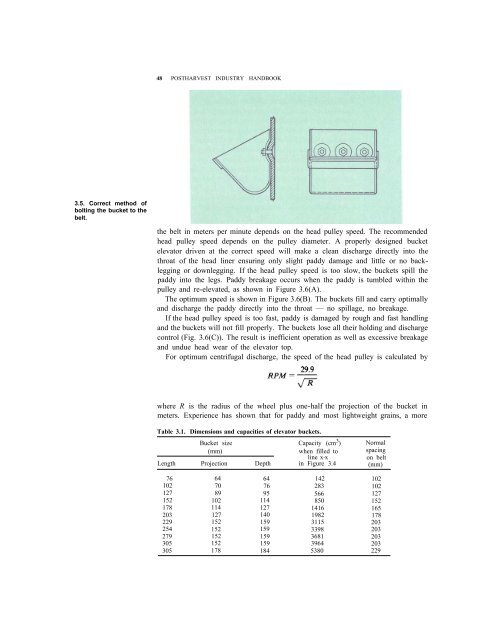Technical handbook for the paddy rice postharvest industry in ...
Technical handbook for the paddy rice postharvest industry in ...
Technical handbook for the paddy rice postharvest industry in ...
Create successful ePaper yourself
Turn your PDF publications into a flip-book with our unique Google optimized e-Paper software.
48 POSTHARVEST INDUSTRY HANDBOOK3.5. Correct method ofbolt<strong>in</strong>g <strong>the</strong> bucket to <strong>the</strong>belt.<strong>the</strong> belt <strong>in</strong> meters per m<strong>in</strong>ute depends on <strong>the</strong> head pulley speed. The recommendedhead pulley speed depends on <strong>the</strong> pulley diameter. A properly designed bucketelevator driven at <strong>the</strong> correct speed will make a clean discharge directly <strong>in</strong>to <strong>the</strong>throat of <strong>the</strong> head l<strong>in</strong>er ensur<strong>in</strong>g only slight <strong>paddy</strong> damage and little or no backlegg<strong>in</strong>gor downlegg<strong>in</strong>g. If <strong>the</strong> head pulley speed is too slow, <strong>the</strong> buckets spill <strong>the</strong><strong>paddy</strong> <strong>in</strong>to <strong>the</strong> legs. Paddy breakage occurs when <strong>the</strong> <strong>paddy</strong> is tumbled with<strong>in</strong> <strong>the</strong>pulley and re-elevated, as shown <strong>in</strong> Figure 3.6(A).The optimum speed is shown <strong>in</strong> Figure 3.6(B). The buckets fill and carry optimallyand discharge <strong>the</strong> <strong>paddy</strong> directly <strong>in</strong>to <strong>the</strong> throat — no spillage, no breakage.If <strong>the</strong> head pulley speed is too fast, <strong>paddy</strong> is damaged by rough and fast handl<strong>in</strong>gand <strong>the</strong> buckets will not fill properly. The buckets lose all <strong>the</strong>ir hold<strong>in</strong>g and dischargecontrol (Fig. 3.6(C)). The result is <strong>in</strong>efficient operation as well as excessive breakageand undue head wear of <strong>the</strong> elevator top.For optimum centrifugal discharge, <strong>the</strong> speed of <strong>the</strong> head pulley is calculated bywhere R is <strong>the</strong> radius of <strong>the</strong> wheel plus one-half <strong>the</strong> projection of <strong>the</strong> bucket <strong>in</strong>meters. Experience has shown that <strong>for</strong> <strong>paddy</strong> and most lightweight gra<strong>in</strong>s, a moreTable 3.1. Dimensions and capacities of elevator buckets.Bucket size Capacity (cm 3 )(mm)when filled tol<strong>in</strong>e x-xLength Projection Depth <strong>in</strong> Figure 3.4Normalspac<strong>in</strong>gon belt(mm)761021271521782032292542793053056470891021141271521521521521786476951141271401591591591591841422835668501416198231153398368139645380102102127152165178203203203203229




![MNC_00_Modau [Compatibility Mode].pdf](https://img.yumpu.com/51432208/1/190x146/mnc-00-modau-compatibility-modepdf.jpg?quality=85)











